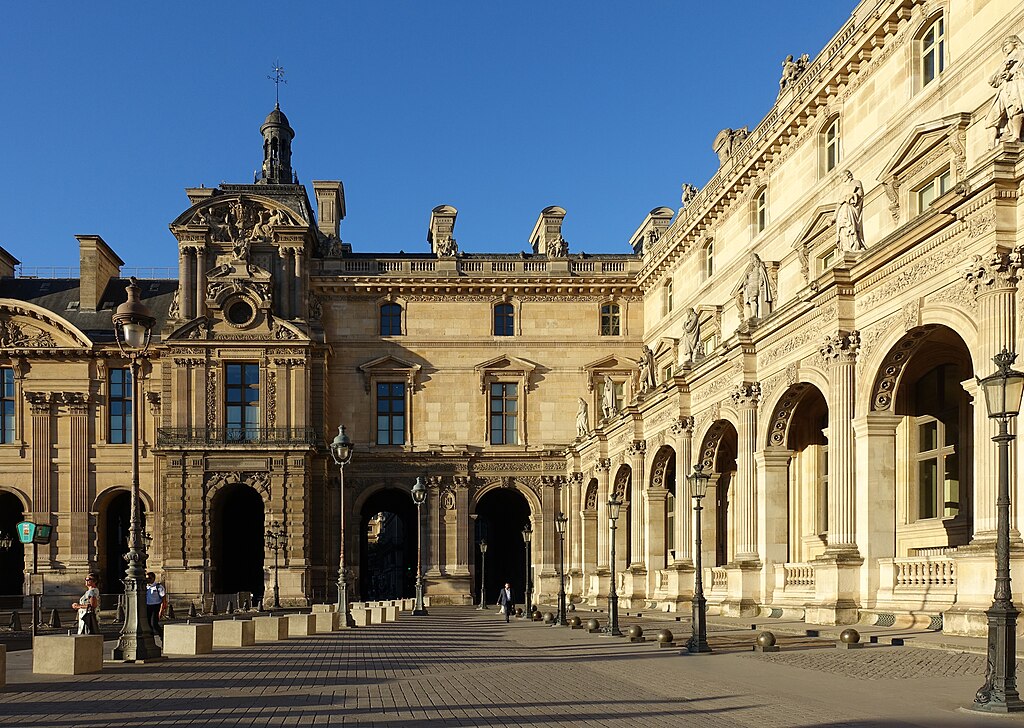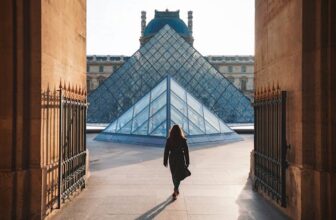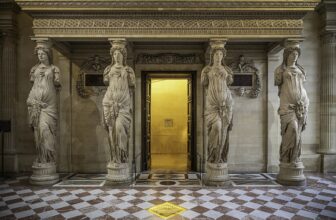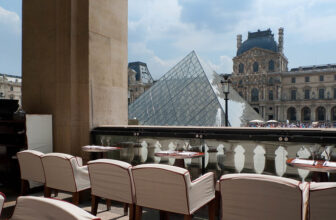
Famous Movies Filmed In The Louvre
The Louvre Museum, an iconic landmark of Paris, holds a prestigious reputation as the world’s most visited art museum. It welcomed over 10 million visitors annually, according to the BBC. With its rich history, vast collection of artworks, and striking architecture, the Louvre has captivated not only art enthusiasts but also filmmakers who seek to incorporate its grandeur into their cinematic narratives. Over the years, the museum has been prominently featured in Hollywood films, adding to its mystique and global appeal.
One of the most notable instances of the Louvre appearing in Hollywood cinema is its role in “The Da Vinci Code” (2006). Based on Dan Brown’s bestselling novel of the same name, the film adaptation starred Tom Hanks as symbologist Robert Langdon. A key sequence in both the book and the movie unfolds within the Louvre itself, where Langdon arrives at the scene of a grisly murder. The victim, curator Jacques Saunière, is discovered in a disturbing pose resembling Leonardo da Vinci’s “The Vitruvian Man,” his body strategically arranged as part of a cryptic message. Given the novel’s immense popularity and the intrigue surrounding its plot, the opportunity to film inside the museum was significant. However, museum officials were initially reluctant to grant permission, perhaps due to the controversy surrounding the book’s fictional claims about religious and historical mysteries. Ultimately, the filmmakers were allowed to shoot inside the Louvre, lending authenticity to the adaptation and showcasing the museum’s dramatic interiors.
Another striking portrayal of the Louvre can be seen in “Wonder Woman” (2017), starring Gal Gadot. The opening scene of the film features Diana Prince, the titular heroine, walking past the glass pyramid in the Louvre’s main courtyard before entering the museum. This choice of setting underscores the Louvre’s status as a symbol of knowledge and timeless artistry, aligning perfectly with Wonder Woman’s own character as an intellectual and warrior. The brief but memorable scene reinforced the museum’s presence in popular culture and introduced it to new generations of moviegoers.
Beyond these two notable examples, the Louvre has made appearances in various other films. In “The Dreamers” (2003), directed by Bernardo Bertolucci, a mesmerizing scene unfolds as the protagonists race through the museum’s halls, echoing a famous sequence from Jean-Luc Godard’s “Bande à Part” (1964). The scene in “Bande à Part” itself was inspired by an attempt to break the record for the fastest tour of the museum, a playful and rebellious moment that has since become a defining image in film history.
The museum also served as a backdrop in “Mission: Impossible – Fallout” (2018), in which Tom Cruise’s character, Ethan Hunt, is seen meeting a key contact near the Louvre’s pyramid. The brief inclusion of the museum in such a high-profile action film reaffirms its global recognition and enduring cinematic appeal.
Part of what makes the Louvre so compelling to filmmakers is its dual identity: it is both a historic institution and a modern architectural marvel. Originally built as a medieval fortress in the late 12th century, the Louvre was transformed into a royal palace before becoming a public museum in 1793 during the French Revolution. Its evolution over the centuries mirrors the changing tides of French history, making it an evocative setting for stories that explore themes of mystery, power, and artistic legacy.
The addition of the glass pyramid entrance in 1989, designed by architect I. M. Pei, further enhanced the Louvre’s cinematic allure. The striking contrast between the pyramid’s sleek, modern lines and the museum’s classical facade creates a visually compelling juxtaposition that filmmakers often use to symbolize the blending of past and present. This architectural feature has been highlighted in numerous films, reinforcing its status as an emblem of Parisian elegance and innovation.
Beyond its physical presence in films, the Louvre’s art collection has also played a crucial role in storytelling. Leonardo da Vinci’s “Mona Lisa,” arguably the most famous painting in the world, has been referenced in countless movies and television shows. Her enigmatic smile and the painting’s layers of historical intrigue make it a frequent subject of artistic and cinematic exploration. The “Mona Lisa” was a focal point in “The Da Vinci Code,” where its supposed hidden meanings fueled the film’s central mystery. Similarly, Eugene Delacroix’s “Liberty Leading the People,” which depicts the July Revolution of 1830, has been featured in various visual narratives as a symbol of resistance and freedom.
Filmmakers often use the Louvre to evoke a sense of wonder, intellectual curiosity, or high stakes. The museum’s dimly lit corridors, grand galleries, and ornate ceilings create an atmosphere of suspense and drama, making it an ideal setting for thrillers, heist films, and historical epics. Additionally, the Louvre’s sheer scale, housing over 35,000 works of art, ensures that it offers an endless array of visual and thematic possibilities for storytellers.
The relationship between the Louvre and cinema is not one-sided; the museum itself has embraced its cinematic connections. In recent years, the Louvre has hosted film screenings, special exhibitions inspired by movies, and even collaborative projects with filmmakers. In 2018, Beyoncé and Jay-Z filmed their music video for “APES**T” inside the museum, showcasing its masterpieces in a bold and modern context. The video, which features the couple standing in front of iconic artworks like the “Mona Lisa” and “The Winged Victory of Samothrace,” became a viral sensation and demonstrated the museum’s ability to engage with contemporary pop culture.
The Louvre’s commitment to accessibility and cultural relevance extends beyond film. The museum has also embraced digital initiatives, allowing audiences worldwide to explore its collections virtually. This digital presence, combined with its frequent cinematic appearances, ensures that the Louvre remains a dynamic and influential institution.
As the world’s most visited museum, the Louvre is more than just a repository of art, it is a living symbol of human creativity and historical continuity. Its presence in Hollywood films amplifies its global significance, inviting audiences to experience its grandeur even from afar. Whether as the backdrop for thrilling mysteries, superhero sagas, or intimate character moments, the Louvre continues to inspire and captivate, solidifying its place as both a cultural and cinematic landmark.
Below is an exploration of notable productions that have featured the Louvre:
1. Belphegor, Phantom of the Louvre (2001)
Directed by Jean-Paul Salomé, this French fantasy film stars Sophie Marceau as Lisa, a young woman who becomes possessed by the spirit of an ancient mummy, Belphegor, after an electrical mishap in the Louvre. The narrative weaves through the museum’s corridors as Lisa, under the mummy’s influence, commits nocturnal thefts of Egyptian artifacts. Notably, this film was among the first to be partially shot inside the Louvre, providing audiences with an authentic glimpse into the museum’s interior.
2. The Da Vinci Code (2006)
Based on Dan Brown’s best-selling novel, this mystery thriller directed by Ron Howard features Tom Hanks as symbologist Robert Langdon. The plot kicks off with a murder inside the Louvre, leading Langdon and cryptologist Sophie Neveu on a quest to unravel secrets hidden within Leonardo da Vinci’s works. The film showcases several scenes set in the Louvre, including the iconic glass pyramid entrance and the gallery housing the Mona Lisa. While some interior scenes were recreated on sets, the production received permission to film certain sequences on-site, adding authenticity to the cinematic experience.
3. Francofonia (2015)
Directed by Alexander Sokurov, this docudrama delves into the relationship between art and power, focusing on the Louvre during the Nazi occupation of France in World War II. The film portrays the collaboration between the museum’s director, Jacques Jaujard, and German officer Franz von Wolff-Metternich, who worked together to protect the museum’s treasures from war-related destruction. Through a blend of dramatization and archival footage, “Francofonia” reflects on the museum’s enduring legacy amidst political turmoil.
4. Lady Gaga’s “The Joker” Music Video (2024)
In a bold fusion of music and art, Lady Gaga filmed the music video for her song “The Joker” inside the Louvre. The video features Gaga exploring the museum’s halls, interacting with various artworks, and notably drawing a red smile on the glass casing of the Mona Lisa. This artistic endeavor aligns with her role as Harley Quinn in the film “Joker: Folie à Deux,” blending her musical persona with cinematic elements.
5. Beyoncé and Jay-Z’s “Apeshit” Music Video (2018)
it’s noteworthy that Beyoncé and Jay-Z filmed their “Apeshit” music video in the Louvre. The video showcases the couple performing amidst the museum’s masterpieces, highlighting works like the Mona Lisa and the Winged Victory of Samothrace. This production emphasizes the intersection of contemporary music and classical art, bringing a modern narrative to the historic setting.
These productions underscore the Louvre’s versatility as a cultural landmark, seamlessly integrating into diverse storytelling mediums. Whether through the lens of cinema or the rhythm of music, the museum continues to inspire and captivate artists and audiences worldwide.
The Louvre’s influence extends far beyond the walls of its galleries. As a landmark of Paris, it serves as a bridge between the past and the present, a place where history, art, and storytelling converge. Its role in Hollywood films, from “The Da Vinci Code” to “Wonder Woman,” underscores its enduring allure and reinforces its status as a beacon of artistic and cultural heritage. Whether viewed through the lens of a camera or in person, the Louvre remains an unparalleled icon in the world of art and cinema. image/wikipedia




